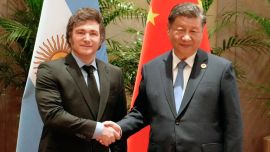Every two to three seconds, someone in the world requires a blood transfusion, and nine out of every 10 people will need a blood transfusion at some point in their life. If three to five percent of Argentine citizens donated just twice a year, the country would meet its required blood supply. Unfortunately, that stable blood supply and donation rate is not the reality.
In Argentina, there are two primary types of blood donors. The first is voluntary donors, who donate of their own free will without a connection to a potential recipient, sometimes doing so fairly often. The second type is replacement donors, who do so because a family member or friend has been hospitalised, and the institution then needs donations to restabilise its supply. In Argentina, the latter group forms the overwhelming majority, almost 70 percent of total donors, according to Oscar Walter Torres, coordinator of the network of transfusional medicine of the Buenos Aires City Health Ministry.
“Unfortunately, in this country, we are still managing the situation with that criterion compared to what it is in Europe or the United States, where a high percentage of donations come from 100 percent voluntary donors,” Walter Torres explained. “In other words, [donors there] are not waiting for someone to call upon them, but rather they regularly give blood two or three times a year, regardless of the recipient. That’s why those countries are self-sufficient.”
In Buenos Aires and across the country, the norm for hospital patients and their families is to do personal outreach among their circles to bring in donors and replace the units of blood needed. Many Argentines have received WhatsApp messages from friends or in group chats asking for help. In fact, hospitals will actively ask patients to run these mini-campaigns so that they can be sure to restabilise supply.
The issue that arises when most are replacement donors, Walter Torres explained, is that hospitals are unable to be self-sufficient in terms of their blood supply. Instead of having stable and replenished reserves to rely on, hospitals must consistently confirm that they are replacing the units needed by their patients. Additionally, a consistent base of voluntary donors is critical in the maintenance of a safe blood supply as such donors see the lowest prevalence of blood-borne infections.
“Among the hospitals overseen by the City of Buenos Aires, in order to be self-sufficient, we need an average of 300 to 350 blood donors a day,” Walter Torres said. “Today, we see an average of 170 to 180.”
Combatting the trend
In an effort to combat these trends, Fundación Hemocentro Buenos Aires, the first regional haemotherapy centre in the nation’s capital, has worked to promote voluntary blood donations.
“We’re working to generate a cultural change that encourages donors to come to donate, not for a specific reason but rather as a habitual practice,” Natalia Lilian Fernández, head of donation promotion at the foundation, told the Times. “With this change, blood donation will be normalised so that it is no longer necessary to request collaboration from patients who are admitted to hospitals.”
One aspect of the foundation’s work is its Donors’ Club, in which enrolled members are called every few months to participate in a blood drive and donate. Fernández explained that many members originally donated for the first time as replacement donors, but upon hearing about the work that the foundation does and the importance of blood donation, opted to join.
Fernández also noted that the foundation, like blood banks in the city, saw a marked drop in donations during the pandemic, both initially during the strict quarantine in Argentina, and again last summer when cases peaked.
“When blood banks are unstable, they depend on external circumstances, which can cause the supply to drop significantly, as occurred during the pandemic,” she said.
Walter Torres added that, with the easing of pandemic restrictions, many potential donors have been unwilling to enter hospitals to donate blood out of fear of contracting Covid-19. To that end, Fernández highlighted the importance of blood drives in community centres and educational institutions, which she said played a critical role in maintaining the supply of blood during the pandemic. These drives brought the opportunity to donate directly to community members, in their neighbourhoods, allowing them to donate without travelling or entering hospitals.
“Since blood cannot be manufactured, it is necessary that people come to donate,” she said.





















Comments